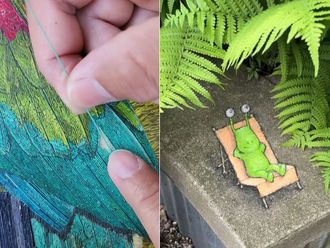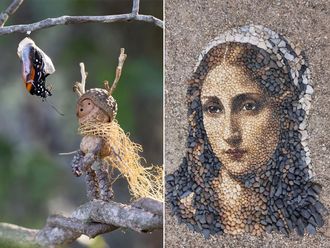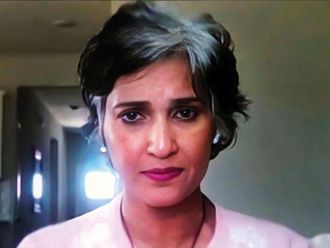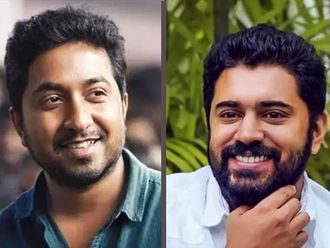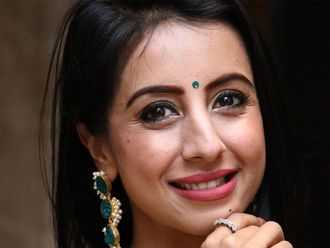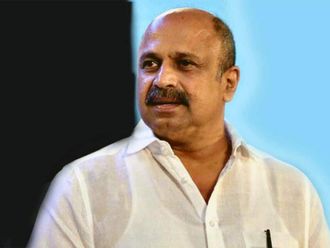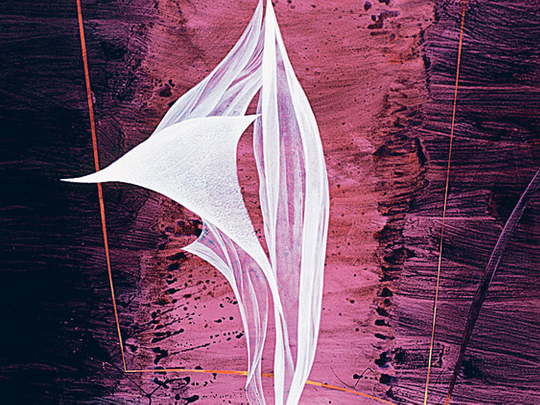
Iranian painter Pooya Aryanpour says he commences every painting "with a sound" and knows a work is complete when it finds its own life. "I prefer to conceal the intentions beneath my interpretations and permit viewers to dig deep to figure out the artistic code that my paintings hold, which will enable them to come up with their interpretation," he said.
Aryanpour seeks the mutual understanding that brings the painter and his paintings closer to the lovers of art. This equation helps bring down the barrier of distraction between the message that the artist wants to convey and the abstractness of the work on display.
Aryanpour was born in Tehran and completed his studies there. He obtained his art diploma from the Plastic Arts School in 1993. For further studies, he joined the Azad University, from where he graduated with BA and MA degrees in painting in 1997 and 1999, respectively.
He started painting as a means of escaping the mundane academic atmosphere. His work is marked by the use of abstract forms inspired by the rhythmic fluidity of calligraphy and is implemented in opaque and translucent white, set against darker background such as red and black.
The 39-year-old artist is holding an exhibition jointly with his friend and compatriot Morteza Darehbaghi. In fact, their long friendship and collaboration is the motivation behind this exhibition.
Aryanpour is showcasing a number of creative visions that are depicted on canvas. "Six of my works on display are from the Floating Objects on the Garden series and four from the Cutting Objects series, besides many others. These works are based on the concepts of intangible and unreachable forms," he said.
Asked about the various aspects of the paintings on display — the colours, the angles and the ideas behind them — he said: "The paintings in Floating Objects on the Garden [2009], for instance, are done in shades of purple and brown. In the Cutting Objects series, sharp objects float in specific directions. The movement of these forms was the essential subject of these paintings. However, in the movement of these forms something happened. This ‘happening' was concentrated at the centre of my works but I myself wasn't conscious about it. My recent works do not experience such ‘happening'. I feel as if artistically it were slightly fading away into the background in my latest work Persian Garden. Well, to me this work is the key to that fundamental occurrence of my previous series. The few forms in the shape of letters are the remains of past memories."
Aryanpour likes to unleash his imagination through different artistic aspects such as painting. "Actually, as an artist, it's not healthy to be restricted in one particular type. In other words, I prefer to communicate my ideas in general terms. The approach I use is abstract but the subjects I express are based on reality and I have an interest in organic forms," he said. "I usually create large-scale paintings because I believe that with larger works it is easier to express the fluidity of floating objects. Most of my showcased works are vertical, which is perhaps an expression of my penchant for highs and lows."
Aryanpour has an adventurous spirit mixed with a curiosity about what lies beyond the visible. This is manifested in his art. "That is absolutely true, the discovery of the unknown and the genuine urge to learn new things and expand my knowledge are the reasons for my attachment to art. Because in my view, art allows thinking, meditating and producing plenty of valuable ideas. Probably that is why I look forward to accomplish change and progression in my artistic path."
Aryanpour has held seven solo exhibitions to date — at the Aun Gallery in 2009; the Niavaran Cultural Centre in 2007; the Cerindipity Gallery, Stockholm, in 2004; the Golestan Gallery in 2003; and the Barg Gallery in 1994, 1997 and 2000.
He has also gained an international recognition by exhibiting his works in countries such as France, Switzerland, Sweden, the United States, China, Kuwait, England, Turkey, Bangladesh, Croatia and recently the UAE.
He appreciates many ancient and contemporary artistic forms. "I value and admire the artistic perspectives of old artists such as C.Y. Twombly and Jean Michel Basquiat. And I feel Jenny Saville and Damien Hirst are forming the pulse of modern art."
Asked about his perspective on life in general, he said: "I believe in dynamism and continuous movement and I hope this is the right path."
Aryanpour thinks that Dubai has become a genuine hub for art. Artists can practise, shine and succeed here, as recent years have witnessed.
"The artworks that have been shown in recent years have been diverse and promising. Some works are genuine and striking, while others are short-term art. By genuine and striking, I mean works that are creative, particularly to the artist, and are therefore unique. By short-term, I mean ‘trendy art' that does not reflect the personal experiences and thoughts of the artist. The point is Dubai has definitely progressed as a great artistic hub for ideas to prosper," he said.
Asked what he would like to tell his admirers and art lovers in general about his work, Aryanpour said: "I am in search of expressing the essence and significance of the subjects I explore and I hope we adopt the same objective."
The joint exhibition of Iranian artists Pooya Aryanpour & Morteza Darehbaghi is on at Meem Gallery until April 11.


